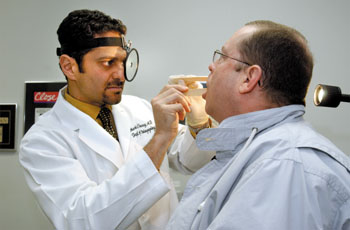
From laser studies to nerve regeneration, otolaryngology research helps physicians like Dr. Mark Courey better treat patients. (photo by Dana Johnson)
Research: to avoid surgery, recharge nerves
The emphasis on otolaryngology surgery research has been on restoring function to damaged or diseased anatomy with minimal morbidity to normal tissue, including a current study in animal models that might return function without surgical intervention, says David Zealear, Ph.D., a neuroscientist and director of research for the department of Otolaryngology.
Vanderbilt developments have advanced the field in the repair of paralyzed vocal cords. Speech production is hindered, or rendered impossible, when one vocal cord is paralyzed – one vocal cord alone can’t do the job. So the aim of treatment is to restore a patient’s functional voice. Dr. James Netterville, professor of Otolaryngology and associate director of the Center, uses specialized instruments that allow him to maneuver a stylized block against the paralyzed cord, fitting it precisely to the patient’s anatomy and maximizing the use of both cords, and thus the patient’s voice.
In bilateral paralysis repair, the vocal cords close shut over the airway, necessitating a sometimes emergent tracheotomy. Dr. Robert Ossoff, director of the Vanderbilt Bill Wilkerson Center for Otolaryngology and Communication Sciences and chair of the department of Otolaryngology, pioneered the use of lasers in arytenoidectomy—the removal of the cartilage that holds the vocal cords in place and creates an airway—and in cordotomy, a procedure that keeps the arytenoids in place, but creates a hole in the back of the vocal cords for an airway.
Zealear, with Dr. Mark Courey, associate professor of Otolaryngology and medical director of the Vanderbilt Voice Center, working on the clinical facets of the study, have been studying ways to bypass conventional surgery and electrically stimulate paralyzed vocal cords with a pacemaker, an implant that would signal the vocal cords to open to let air flow in and close for swallowing and voice production.
“Originally, it was a great engineering project,” says Zealear, associate professor of Otolaryngology. But the researchers stumbled onto an important discovery. A small percentage of patients with vocal cord paralysis have spontaneous recovery—the damaged nerves are replaced with regenerated nerve fibers to control the muscles. Surgeons usually wait six months to see if this would occur before performing a cordotomy or arytenoidectomy, Zealear says. It was suspected that early electrical stimulation would interfere with this natural regeneration.
But, Zealear says, they found the opposite to be true. “Electrical stimulation not only encourages regeneration, but it guides the nerve fibers back to the original muscles and prevents foreign nerves from encroaching,” he says.
Therefore, early stimulation is preferred. And, Zealear says, it might be possible one day to inject a series of tiny stimulators around the vocal cord muscles that are controlled by telemetry. The patient would receive stimulation until natural regeneration occurs, then the telemetry would stop, and the implants could stay in.
In other laser research, Lou Reinisch, Ph.D., a physicist, associate professor of Otolaryngology and director of Laser Research, is currently testing a CO2 laser with a short pulse structure, similar to that of the Free Electron Laser, to create less thermal damage and shorter healing time in otolaryngology surgery. He also is testing an ultraviolet light that identifies bacteria in the middle ears of children with otitis media. The light shines through the eardrum, the bacteria absorb it and fluoresce different colors. An analysis identifies the bacteria by color so physicians can accurately prescribe antibiotics. This technique has caught the attention of the Department of Defense, which is interested in its use to identify anthrax bacteria.
Still more work is examining collagen and other matrices, including reconstituted tissue, to find a way to prevent scarring and bleeding in laryngeal surgeries, and to restore the natural mucosal texture, Ossoff says.













